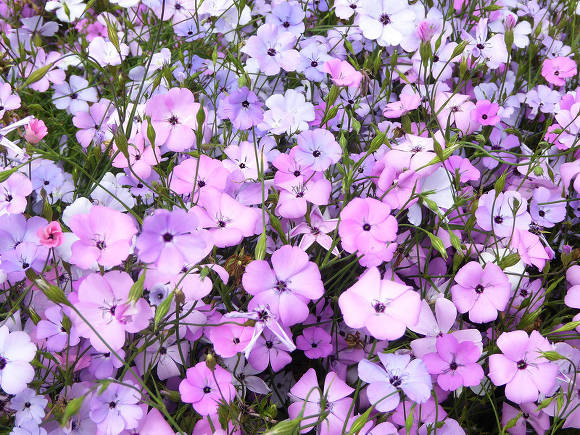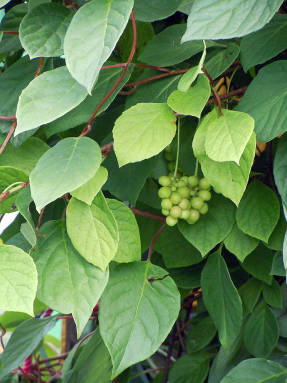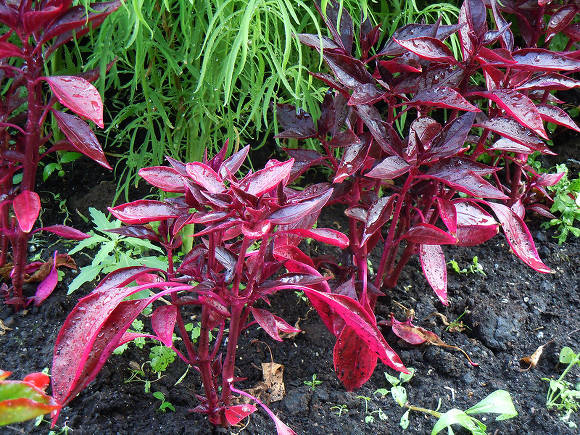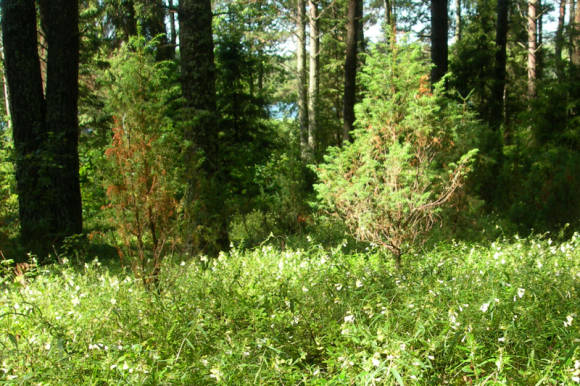Continuation of the cycle "Perennials easy to care for" beginning in articles:
- Perennials, easy to care for
- Astilbe, small petals and heliopsis
- Yarrow - a thousand leaves and flowers
- Loosestrife, or weeping grass
- Buzulniks, highlanders, burners
- Geleniums - flowers of autumn
Physostegia (Physostegia)
Physostegia virginian (Physostegia virginiana) good in autumn, it belongs to the family of the lacustrine. The flowers are collected in spike-shaped inflorescences, their color is not very diverse: pink-lilac and white. It is a perennial herb 80-90 cm tall. It hibernates without shelter, practically not affected by any diseases. Grows well both in the sun and in the shade on loose, moist soil. It grows easily, therefore it requires attention so that it does not become an aggressor.
Reproduction... Physostegia is propagated by cuttings in the first half of summer, and even easier - by dividing the bush in the first half of summer. The main thing to care for is abundant watering and well-fertilized soil. There is a garden form with white flowers and several varieties of delicate colors - white, pink, lilac:
- Vivid (Vivid), 60-65 cm, pink flowers;
- Summer Snow (Summer Snow), up to 90 cm, white flowers;
- Summer Spire (Summer Spire), up to 90 cm, deep pink flowers.
- The most beautiful variety - Variegata (Variegata), 80 cm high, purple-pink flowers, green leaves with a white border, dense spike-shaped inflorescence. Blooms in the second half of August, blooms almost until frost.
 |  |
In garden design, physical activity is especially good in small groups, in mixborders, near bodies of water. A lush, ornamental bush of physostegy looks great in single plantings on flower beds and ridges, as a tapeworm it is used to decorate lawns.
Physostegy will add sophistication to a perennial mixboder. In combination with Veronica, Meadowsweet, Liatrix, Physostegy fits perfectly into the design of flowering flower beds, landscape design of park zones and city squares.
We will braid the braids at the chelone
Helone (Chelone), like many other plants, it came to us from North America, where it grows in humid places, on the edges of forests and meadows. In decorative floriculture, there are Helone nude(Chelone glabra), helone green-flowered (Chelone chlorantha), helone oblique (Chelone obliqua), NSElone Lyona (Chelone lyonii). The most widespread are two types: chelone oblique and chelone Lyona.

Slanting Helone is a perennial herb 50-60 cm high. Shoots are straight and strong. Leaves are green, with clear veins, lanceolate with an elongated end, slightly serrated edges. Large flowers are collected in short, as if braided in pigtails, spike-shaped inflorescences formed at the tops of the shoots.
Helone withstands the transplant without problems, takes root easily. You can transplant it during flowering. It can grow for a long time in one place without a transplant. Helone, thanks to weakly creeping rhizomes, forms rather dense clumps, growing in width up to 50 cm.
Helone varieties
Helone oblique has varieties with different flower colors - pink Rosea (Rozea), white Alba (Alba) and white with pink tips Pink Tötle (Pink Turtle).

Compared to other species, in the Lyon chelone, everything is larger and brighter, and the bush itself, and the leaves, and flowers. Helone Lyona forms dense clumps with strong stems up to a meter high. The leaves are large, dark green, shiny, sessile, oval-lanceolate, with small, clear denticles. Helone Lyon has a variety Hot Lips (Hot Lips).
Chelone blooms in the middle lane in August. According to its parameters, chelone is just a wonderful plant. According to the growing conditions, chelone belongs to plants of the 3-4th zone, that is, it is quite winter-hardy and hardy not only in central Russia, but also in more frosty conditions. This perennial has a lot of advantages: it grows quickly and well, it grows on almost any soil, it multiplies easily. In spring, overwintered rhizome gives new elastic stems.
Helone perfectly adapts to any soils, grows well on moderately fertile and clayey, but, of course, it develops better on nutrient soils with a sufficient amount of moisture. In some articles, the moisture-loving nature of the plant is especially emphasized, but for me it grows in a sunny place and is not often watered, it looks pretty decent. And in the dry and hot summer of 2010, when there was not enough water at all, it grew well, bloomed, though not so good. Helone grows well both in a flower garden and on the banks of a garden reservoir. This plant can not only solo in the garden, but also works great in a team, and not only with shade-loving: ferns, kupins, sedges, but also with light-loving plants: phlox, liatrix, veronica.
For more than 7 years, I have been growing two varieties of chelone oblique - white, pink and chelone Lyona. I don't see any particular beauty in the scythe chelon, I keep it as an exotic with which there are no problems. But Lyona is my joy and pride, it is not for nothing that she was put in a ceremonial place. The bush is tall, does not require a garter, the stems are straight, with beautiful shiny foliage. The leaves are large, with serrated edging. The bush is good at any time of the year, the foliage is always bright and healthy. But it especially attracts attention in autumn, when the tops of the shoots are decorated with pigtails with bright dark pink unusual flowers.
The structure of the flower is similar to the head of a turtle, so in England this plant is called "turtle head" (turtlehead). I call these flowers "lip-flaps", the corolla of the flower is two-lipped, like in all norichnikovs, the upper lip is convex, and the lower one is protruding. According to Greek mythology, Helone is a nymph who, having insulted the gods Zeus and Hera, refused to come to their wedding, was turned into a turtle.
Chelone bloom begins in August, continues in September and even in October. At the end of October, the bush continues to bloom and stands so beautiful that the hand does not rise to cut the shoots, I cut it for the winter along with the shelter of roses.

Growing helone
The soil... The soil should be well-drained, nutritious, loamy, moist, with a pH level of 5 to 7, i.e. need soils from mildly acidic to neutral. Top dressing - organic or mineral, 1-2 times per season.
Reproduction... Helone is propagated by dividing the bush or by cuttings. You can take cuttings with a 6-7 cm heel in spring or cut from the tops of the shoots and lateral shoots in the first half of June. Cuttings root perfectly both under a plastic bottle and in a cuticle. You just need to carefully monitor so that the soil does not dry out. Roots are formed within a month. Grown plants are planted in a permanent place in the fall in ordinary soil, adding a little fertilizer to the planting hole.
The bushes are divided in the spring. The bush is dug up, it can be split into pieces by hand or cut and planted in a new place. After division, the chelone takes root well, in one place without transplanting it can grow for a long time, its roots, although creeping, are not aggressive. Due to their dense arrangement, weeds cannot break through the roots, and this is also a plus for my pet. I would say that the nature of the plant is Nordic, probably due to this the plant does not get sick and is not damaged by snails. Sometimes holes appear on the leaves, but there are not many of them.
A look at the overgrown tall bush blooming with a pleasant pink color combined with shiny green foliage creates a feeling of comfort, harmony and celebration in the garden.
End of cycle "Perennials, easy to care for" read in the article:
- Unpretentious ferns
Photo by the author







